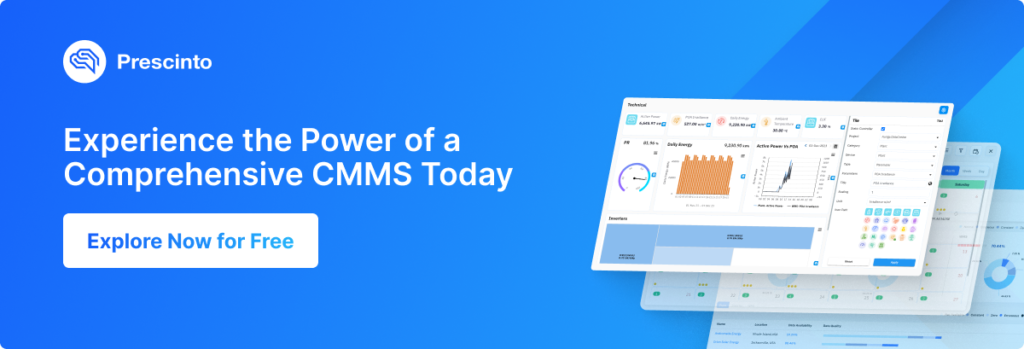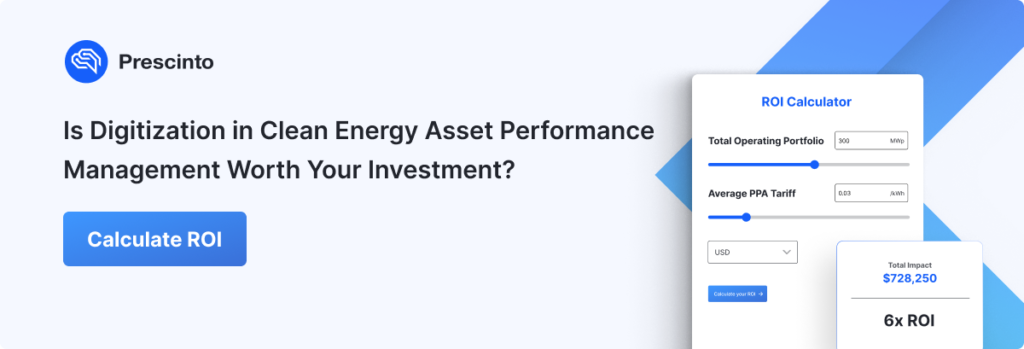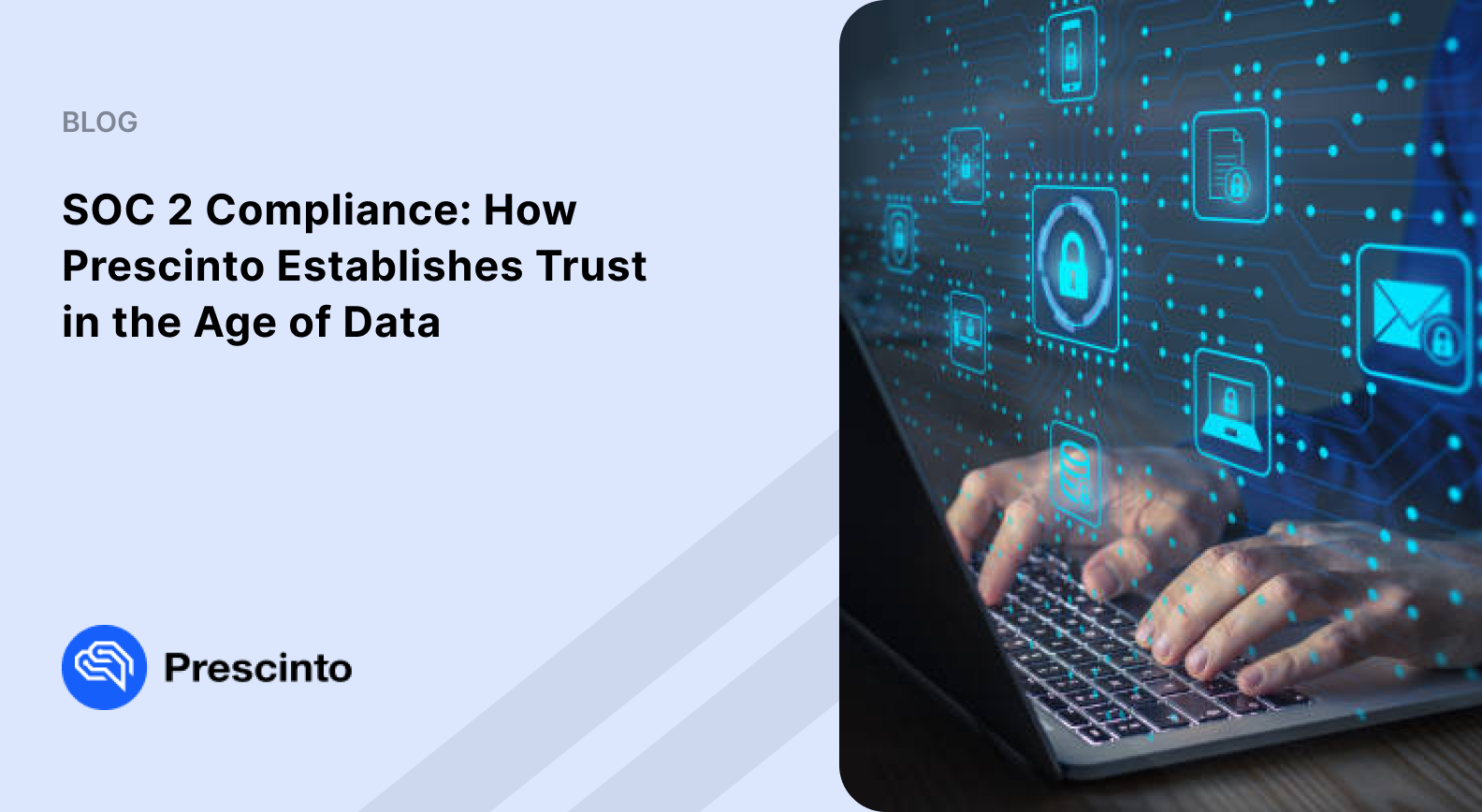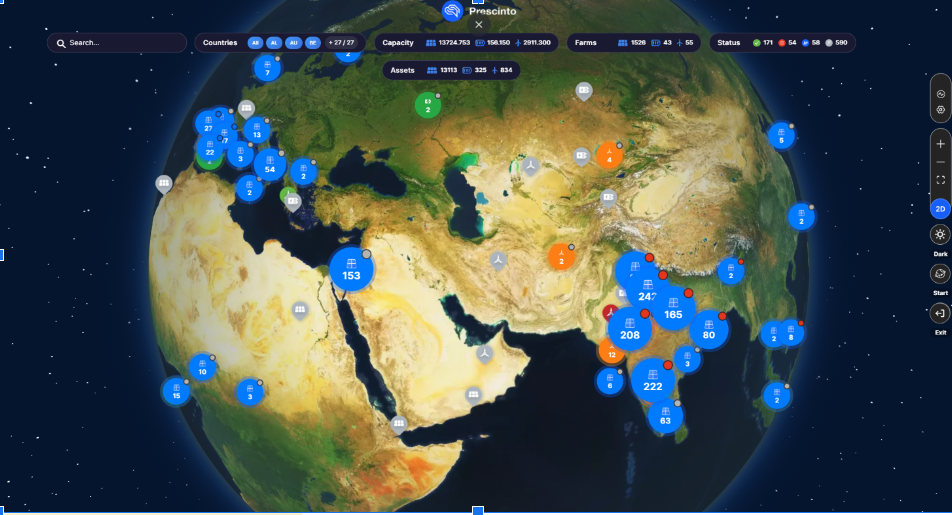The Profit Drain: Ignoring CMMS Siphons Solar Asset’s Earnings!
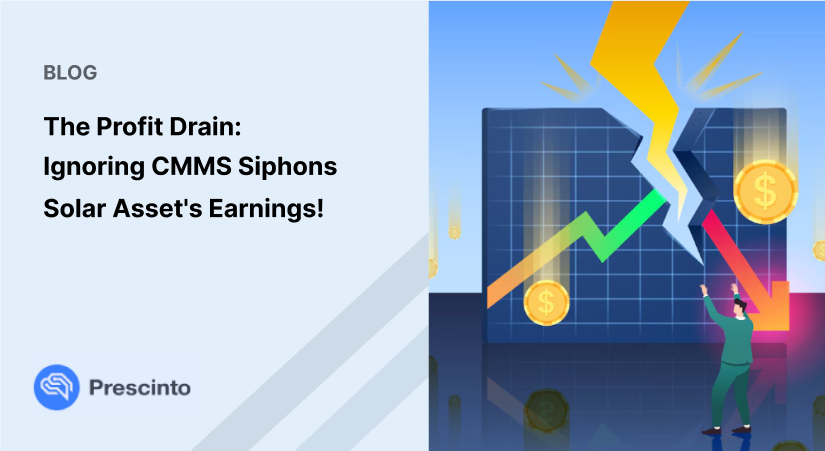
- March 28, 2024
- Prescinto
Choosing the right technologies and tools is vital for long-term success and a favorable ROI in solar PV plants. To improve the financial performance of a solar asset, O&M teams and asset managers must reduce daily losses and control operational costs. Without effective digital tools at their disposal, O&M teams may struggle to prioritize maintenance tasks and allocate resources effectively. This can result in reactive maintenance practices, where maintenance is performed only after a breakdown occurs, leading to increased downtime and higher repair costs. The missing digital piece to solving this puzzle is a Computerized Maintenance Management System (CMMS).
What is CMMS for Solar?
CMMS stands for Computerized Maintenance Management System. It is a software solution used in solar plants to manage and track maintenance activities, equipment, and resources.
It helps manage assets, schedule maintenance, and track work orders in a solar plant.
CMMS makes maintenance easier, reduces downtime, uses resources better, and provides helpful insights. This makes it a strategic tool for the success of solar plants and increases asset’s earnings.
How Does CMMS Become a Strategic Digital Tool for Solar Plants?
Maintaining large solar energy portfolio operations means managing teams and workflows efficiently. A 100 MWp solar PV power plant may have more than 320K PV modules spread across 500 Acres of Land. The complexity of operations increases further as portfolios spread out across multiple geographical locations. Management of such scale and spread needs appropriate systems and efficient processes.
CMMS provides real-time digital mapping of all the ongoing, upcoming, and concluded operational activities. It gives all the relevant stakeholders detailed digital accounts of all the assets, resources, and activities. To maintain the quality of data, all features of CMMS can be granted restricted access across departments and employees. CMMS can also be implemented to operate at portfolio and individual project levels.
How an Inefficient Computerized Maintenance Management System (CMMS) Drains Profits
The ineffective CMMS not only increases OPEX through inefficient resource allocation and maintenance practices but also directly impacts revenue streams. Let’s take a look at some of the critical challenges solar asset managers and O&M service providers face without a comprehensive CMMS.
Inefficient Work Order Management and Increased Downtime
Without a centralized system, operators struggle to track maintenance and repair activities. Important tasks, such as repairs for malfunctioning equipment, cleaning, and monitoring of systems could be delayed due to a lack of visibility and coordination. When maintenance tasks are not proactively managed and issues are addressed only after they occur, solar panels may remain offline for extended periods, resulting in lost revenue from energy generation. Research conducted by Infosys has shown that solar energy production may reduce by 17%–25% if maintenance activities are delayed at solar plants and solar PV panels are not cleaned regularly.
Additionally, solely resorting to reactive maintenance often incurs higher repair costs and accelerates equipment wear, leading to increased expenses and decreased equipment lifespan. Frequent downtime can also lead to contractual penalties, tarnishing the O&M provider’s reputation and resulting in missed revenue opportunities.
Limited Data Visibility And Decision-Making Challenges
Limited data visibility and resource allocation challenges in solar assets – stem from the absence of a centralized system for collecting, analyzing, and managing performance data. Without a comprehensive CMMS, operators face difficulty in consolidating data from various sources, including equipment sensors, maintenance logs, work orders, and performance reports. Manual data aggregation and analysis are prone to errors, consuming both time and money. McKinsey & Company estimates that inefficient data management practices cost companies around USD 20 billion annually, while IBM research suggests that manual data entry errors can incur average costs of USD 14,000 per employee per year. This lack of data visibility means operators may miss crucial insights into equipment performance, trends, and areas for improvement.
Additionally, without an effective CMMS to facilitate resource allocation, operators may struggle to coordinate manpower and equipment efficiently, leading to increased operational costs. Without a CMMS, operators are hindered in their ability to make informed decisions and allocate resources effectively, ultimately impacting the performance and profitability of their assets.
Lack of Maintenance Strategies and Risk of Failures
Without CMMS, planning maintenance is difficult and problems may not be fixed before they become critical. Solar plants without a CMMS face increased risks of equipment failures, leading to reduced efficiency and potentially costly downtime. Not having effective CMMS software often means maintenance is done only when problems come up. It results in increased downtime and higher repair costs.
As per the US Department of Energy (US DOE), O&M best practices reduce equipment and process failure. The DOE estimates that preventive maintenance generates 12% -18% cost savings over reactive maintenance programs.
Using Manual Processes with weak results
The cost of a one-hour downtime during peak production times of a 100 MW solar PV power plant is devastating. Many organizations rely on the manual process of maintenance and communicate through calls, WhatsApp, Excel spreadsheets, and emails. Using manual processes to resolve downtime leads to weak and delayed results.
Difficulty in Regulatory Compliance
Difficulty in regulatory compliance for solar plants arises from evolving regulations, complex permitting processes, environmental impact assessments, grid connection requirements, and health and safety regulations. Non-compliance can lead to hefty fines, project delays, and reputational damage.
Benefits of Using a Comprehensive Computerized Maintenance Management System
To overcome the challenges mentioned earlier, a unified CMMS is essential. By streamlining maintenance tasks, an effective CMMS improves time-based and production-based availability, reduces reactive maintenance, and enhances preventive maintenance effectiveness.
Streamlining Maintenance Operations
CMMS in solar plants sets up one place to manage maintenance. This makes sure solar panels and inverters are looked after well, reducing downtime and having more output.
CMMS helps to make maintenance operations smoother and more organized. It helps in scheduling maintenance tasks effectively, tracking work orders, and keeping maintenance records daily. This ensures that maintenance activities are carried out efficiently, reducing downtime and improving overall plant performance.
Proactive Maintenance Strategies
With CMMS, plant operators can shift from reactive to proactive maintenance approaches. It plans maintenance in advance and uses real-time data.
Proactive maintenance strategies in CMMS for solar plants involve regularly checking equipment, fixing minor issues before they become major problems, and keeping detailed records of maintenance activities. This helps prevent unexpected breakdowns and keeps the plant running efficiently.
Reducing Downtime and Enhancing Availability
CMMS in solar plants helps to decrease downtime and improve availability by scheduling maintenance well, fixing equipment problems quickly, and making sure spare parts are readily available. This keeps the plant running smoothly and ensures energy production stays on track. It thereby impacts profit margins positively.
Optimizing Resource Allocation
CMMS helps solar plants use their resources better. It makes sure maintenance happens at the right times, keeps track of what parts they have, schedules workers efficiently, and prioritizes tasks based on what’s most important and what resources are available. This helps the plant run smoothly and prevents wastage of time or materials.
Comprehensive Data for Informed Decision-Making
CMMS in solar plants provides comprehensive data essential for informed decision-making. It tracks equipment performance, maintenance history, energy production, and regulatory compliance issues. This data enables operators to optimize maintenance schedules, identify performance trends, and ensure adherence to environmental and safety regulations. These steps ultimately enhance operational efficiency and maximize energy output. Solar plant operators can use this data to make smart decisions.
To maintain field devices at the best of their performance, precise data gathering is the starting point. Manual processes to collect data are prone to human error, and tracing erroneous data is almost equivalent to reworking complete data sets.
Ensuring Compliance and Safety
Solar plants must adhere to various regulations and compliance issues to ensure environmental sustainability, safety, and efficient grid integration. Key aspects include environmental regulations covering land use and waste management, safety standards such as OSHA guidelines, grid connection requirements, and considerations for grid stability and power quality. Compliance with these factors is essential for avoiding fines and penalties for non-compliance.
CMMS in solar plants helps ensure compliance and safety by streamlining maintenance schedules, tracking equipment inspections, managing regulatory documentation, and facilitating timely repairs. This helps the solar plant stay safe and financially secure.
How Prescinto Helps- Most Comprehensive CMMS Solution
The implementation of a CMMS is a strategic move for solar plants aiming to enhance their profit margins. Prescinto’s CMMS Module is used to plan and manage the operations of large renewable energy portfolios. Prescinto has developed a CMMS, catering to the specific requirements of clean energy power plants.
Plan, Track, and Visualize Daily Operations
Prescinto’s CMMS is more than just a record-keeping tool. It can also simplify day-to-day operations by providing a plug-and-play framework for planning operations, setting up automation for repetitive tasks, and providing a strong audit trail. The CMMS helps quickly visualize gaps between planned and actual statuses of plant operations.
Moreover, there is a unique ability to plan and document activities like inverter preventive maintenance, wind turbine preventive maintenance, corrective maintenance, module cleaning, grass cutting, material ordering, and a detailed account of materials received within the CMMS module.
Integrate with Existing ERP Solutions
If a portfolio is already using an ERP system and doesn’t want to manage and update multiple management systems, then Prescinto CMMS is the perfect choice. All data consolidated in the CMMS system can directly interact with ERP systems such as Microsoft NAV through custom APIs.
Inventory and Spare Parts Management
Prescinto’s CMMS module also includes inventory and spare parts management. Plant operators can keep track of all inventory used during preventive or corrective maintenance. Therefore they can smoothly generate purchase orders or raise requests when the number of spares goes below the minimum stock-keeping unit.
When dealing with large orders, all materials may not be delivered to the site at once. With the CMMS module, one can also track the status of materials that have been received and those that are pending.
Environmental Health Safety and Compliance
Work permits are crucial for the safety of the site team. It ensures that the team doesn’t encounter any hazards and reduces the impact of human errors while performing maintenance activities. Operators at the site need to be aware of and follow safety protocols while performing maintenance activities. This involves working at heights, dealing with high voltages, etc. Prescinto’s predefined workflow management takes care of the approvals and work permits required by the site team before they can execute the assigned task.
The CMMS module helps document and track every incident that happened at the site. This allows senior management to implement corrective actions, including work permits.
Mobile App Capabilities
Site engineers are always on the go, and carrying a laptop at all times is challenging and cumbersome. Working off printed sheets further duplicates efforts and complicates the audit trail.
With Prescinto’s CMMS mobile application, they can access CMMS functionalities anywhere. This allows them to create, track, and update all work orders, including work orders for corrective maintenance.
Additionally, the team has the ability to view a comprehensive calendar display and upload images of sites and equipment both before and after completing any maintenance tasks. They also get access to a straightforward monitoring dashboard, offering key insights into generation, PR, CUF, and other relevant data at a glance.
Prescinto’s CMMS module not only promotes transparency and accountability but also visualizes the contributions of all stakeholders to the successful operation and maintenance of the portfolio. It serves as a crucial link between planning and execution.
Utilize Prescinto’s next-generation CMMS module, which can scale alongside business growth to handle increased complexities effectively.
About Author

